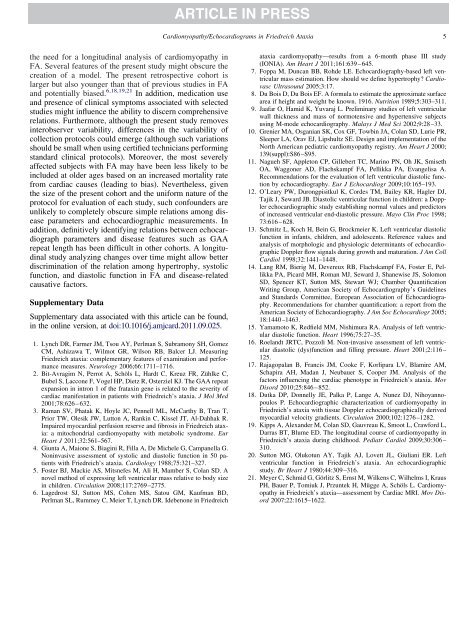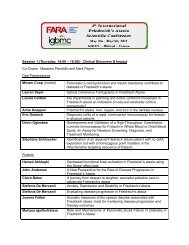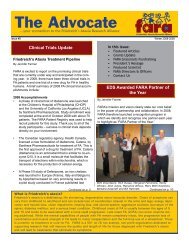Analysis of Echocardiograms in a Large Heterogeneous Cohort of ...
Analysis of Echocardiograms in a Large Heterogeneous Cohort of ...
Analysis of Echocardiograms in a Large Heterogeneous Cohort of ...
You also want an ePaper? Increase the reach of your titles
YUMPU automatically turns print PDFs into web optimized ePapers that Google loves.
the need for a longitud<strong>in</strong>al analysis <strong>of</strong> cardiomyopathy <strong>in</strong><br />
FA. Several features <strong>of</strong> the present study might obscure the<br />
creation <strong>of</strong> a model. The present retrospective cohort is<br />
larger but also younger than that <strong>of</strong> previous studies <strong>in</strong> FA<br />
and potentially biased. 6,18,19,21 In addition, medication use<br />
and presence <strong>of</strong> cl<strong>in</strong>ical symptoms associated with selected<br />
studies might <strong>in</strong>fluence the ability to discern comprehensive<br />
relations. Furthermore, although the present study removes<br />
<strong>in</strong>terobserver variability, differences <strong>in</strong> the variability <strong>of</strong><br />
collection protocols could emerge (although such variations<br />
should be small when us<strong>in</strong>g certified technicians perform<strong>in</strong>g<br />
standard cl<strong>in</strong>ical protocols). Moreover, the most severely<br />
affected subjects with FA may have been less likely to be<br />
<strong>in</strong>cluded at older ages based on an <strong>in</strong>creased mortality rate<br />
from cardiac causes (lead<strong>in</strong>g to bias). Nevertheless, given<br />
the size <strong>of</strong> the present cohort and the uniform nature <strong>of</strong> the<br />
protocol for evaluation <strong>of</strong> each study, such confounders are<br />
unlikely to completely obscure simple relations among disease<br />
parameters and echocardiographic measurements. In<br />
addition, def<strong>in</strong>itively identify<strong>in</strong>g relations between echocardiograph<br />
parameters and disease features such as GAA<br />
repeat length has been difficult <strong>in</strong> other cohorts. A longitud<strong>in</strong>al<br />
study analyz<strong>in</strong>g changes over time might allow better<br />
discrim<strong>in</strong>ation <strong>of</strong> the relation among hypertrophy, systolic<br />
function, and diastolic function <strong>in</strong> FA and disease-related<br />
causative factors.<br />
Supplementary Data<br />
Supplementary data associated with this article can be found,<br />
<strong>in</strong> the onl<strong>in</strong>e version, at doi:10.1016/j.amjcard.2011.09.025.<br />
1. Lynch DR, Farmer JM, Tsou AY, Perlman S, Subramony SH, Gomez<br />
CM, Ashizawa T, Wilmot GR, Wilson RB, Balcer LJ. Measur<strong>in</strong>g<br />
Friedreich ataxia: complementary features <strong>of</strong> exam<strong>in</strong>ation and performance<br />
measures. Neurology 2006;66:1711–1716.<br />
2. Bit-Avragim N, Perrot A, Schöls L, Hardt C, Kreuz FR, Zühlke C,<br />
Bubel S, Laccone F, Vogel HP, Dietz R, Osterziel KJ. The GAA repeat<br />
expansion <strong>in</strong> <strong>in</strong>tron 1 <strong>of</strong> the fratax<strong>in</strong> gene is related to the severity <strong>of</strong><br />
cardiac manifestation <strong>in</strong> patients with Friedreich’s ataxia. J Mol Med<br />
2001;78:626–632.<br />
3. Raman SV, Phatak K, Hoyle JC, Pennell ML, McCarthy B, Tran T,<br />
Prior TW, Olesik JW, Lutton A, Rank<strong>in</strong> C, Kissel JT, Al-Dahhak R.<br />
Impaired myocardial perfusion reserve and fibrosis <strong>in</strong> Friedreich ataxia:<br />
a mitochondrial cardiomyopathy with metabolic syndrome. Eur<br />
Heart J 2011;32:561–567.<br />
4. Giunta A, Maione S, Biag<strong>in</strong>i R, Filla A, De Michele G, Campanella G.<br />
Non<strong>in</strong>vasive assessment <strong>of</strong> systolic and diastolic function <strong>in</strong> 50 patients<br />
with Friedreich’s ataxia. Cardiology 1988;75:321–327.<br />
5. Foster BJ, Mackie AS, Mitsnefes M, Ali H, Mamber S, Colan SD. A<br />
novel method <strong>of</strong> express<strong>in</strong>g left ventricular mass relative to body size<br />
<strong>in</strong> children. Circulation 2008;117:2769–2775.<br />
6. Lagedrost SJ, Sutton MS, Cohen MS, Satou GM, Kaufman BD,<br />
Perlman SL, Rummey C, Meier T, Lynch DR. Idebenone <strong>in</strong> Friedreich<br />
Cardiomyopathy/<strong>Echocardiograms</strong> <strong>in</strong> Friedreich Ataxia<br />
ataxia cardiomyopathy—results from a 6-month phase III study<br />
(IONIA). Am Heart J 2011;161:639–645.<br />
7. Foppa M, Duncan BB, Rohde LE. Echocardiography-based left ventricular<br />
mass estimation. How should we def<strong>in</strong>e hypertrophy? Cardiovasc<br />
Ultrasound 2005;3:17.<br />
8. Du Bois D, Du Bois EF. A formula to estimate the approximate surface<br />
area if height and weight be known. 1916. Nutrition 1989;5:303–311.<br />
9. Jaafar O, Hamid K, Yuvaraj L. Prelim<strong>in</strong>ary studies <strong>of</strong> left ventricular<br />
wall thickness and mass <strong>of</strong> normotensive and hypertensive subjects<br />
us<strong>in</strong>g M-mode echocardiography. Malays J Med Sci 2002;9:28–33.<br />
10. Grenier MA, Osganian SK, Cox GF, Towb<strong>in</strong> JA, Colan SD, Lurie PR,<br />
Sleeper LA, Orav EJ, Lipshultz SE. Design and implementation <strong>of</strong> the<br />
North American pediatric cardiomyopathy registry. Am Heart J 2000;<br />
139(suppl):S86–S95.<br />
11. Nagueh SF, Appleton CP, Gillebert TC, Mar<strong>in</strong>o PN, Oh JK, Smiseth<br />
OA, Waggoner AD, Flachskampf FA, Pellikka PA, Evangelisa A.<br />
Recommendations for the evaluation <strong>of</strong> left ventricular diastolic function<br />
by echocardiography. Eur J Echocardiogr 2009;10:165–193.<br />
12. O’Leary PW, Durongpisitkul K, Cordes TM, Bailey KR, Hagler DJ,<br />
Tajik J, Seward JB. Diastolic ventricular function <strong>in</strong> children: a Doppler<br />
echocardiographic study establish<strong>in</strong>g normal values and predictors<br />
<strong>of</strong> <strong>in</strong>creased ventricular end-diastolic pressure. Mayo Cl<strong>in</strong> Proc 1998;<br />
73:616–628.<br />
13. Schmitz L, Koch H, Be<strong>in</strong> G, Brockmeier K. Left ventricular diastolic<br />
function <strong>in</strong> <strong>in</strong>fants, children, and adolescents. Reference values and<br />
analysis <strong>of</strong> morphologic and physiologic determ<strong>in</strong>ants <strong>of</strong> echocardiographic<br />
Doppler flow signals dur<strong>in</strong>g growth and maturation. J Am Coll<br />
Cardiol 1998;32:1441–1448.<br />
14. Lang RM, Bierig M, Devereux RB, Flachskampf FA, Foster E, Pellikka<br />
PA, Picard MH, Roman MJ, Seward J, Shanewise JS, Solomon<br />
SD, Spencer KT, Sutton MS, Stewart WJ; Chamber Quantification<br />
Writ<strong>in</strong>g Group, American Society <strong>of</strong> Echocardiography’s Guidel<strong>in</strong>es<br />
and Standards Committee, European Association <strong>of</strong> Echocardiography.<br />
Recommendations for chamber quantification: a report from the<br />
American Society <strong>of</strong> Echocardiography. J Am Soc Echocardiogr 2005;<br />
18:1440–1463.<br />
15. Yamamoto K, Redfield MM, Nishimura RA. <strong>Analysis</strong> <strong>of</strong> left ventricular<br />
diastolic function. Heart 1996;75:27–35.<br />
16. Roelandt JRTC, Pozzoli M. Non-<strong>in</strong>vasive assessment <strong>of</strong> left ventricular<br />
diastolic (dys)function and fill<strong>in</strong>g pressure. Heart 2001;2:116–<br />
125.<br />
17. Rajagopalan B, Francis JM, Cooke F, Korlipara LV, Blamire AM,<br />
Schapira AH, Madan J, Neubauer S, Cooper JM. <strong>Analysis</strong> <strong>of</strong> the<br />
factors <strong>in</strong>fluenc<strong>in</strong>g the cardiac phenotype <strong>in</strong> Friedreich’s ataxia. Mov<br />
Disord 2010;25:846–852.<br />
18. Dutka DP, Donnelly JE, Palka P, Lange A, Nunez DJ, Nihoyannopoulos<br />
P. Echocardiographic characterization <strong>of</strong> cardiomyopathy <strong>in</strong><br />
Friedreich’s ataxia with tissue Doppler echocardiographically derived<br />
myocardial velocity gradients. Circulation 2000;102:1276–1282.<br />
19. Kipps A, Alexander M, Colan SD, Gauvreau K, Smoot L, Crawford L,<br />
Darras BT, Blume ED. The longitud<strong>in</strong>al course <strong>of</strong> cardiomyopathy <strong>in</strong><br />
Friedreich’s ataxia dur<strong>in</strong>g childhood. Pediatr Cardiol 2009;30:306–<br />
310.<br />
20. Sutton MG, Olukotun AY, Tajik AJ, Lovett JL, Giuliani ER. Left<br />
ventricular function <strong>in</strong> Friedreich’s ataxia. An echocardiographic<br />
study. Br Heart J 1980;44:309–316.<br />
21. Meyer C, Schmid G, Görlitz S, Ernst M, Wilkens C, Wilhelms I, Kraus<br />
PH, Bauer P, Tomiuk J, Przuntek H, Mügge A, Schöls L. Cardiomyopathy<br />
<strong>in</strong> Friedreich’s ataxia—assessment by Cardiac MRI. Mov Disord<br />
2007;22:1615–1622.<br />
5





